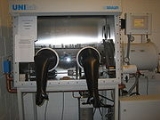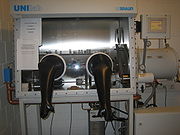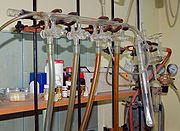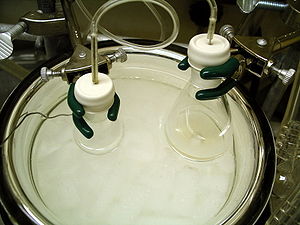
Air-free technique
Encyclopedia
Air-free techniques refer to a range of manipulations in the chemistry laboratory
for the handling of compounds that are air-sensitive. These techniques prevent the compounds from reacting with components of air, usually water
and oxygen
; less commonly carbon dioxide
and nitrogen
. A common theme among these techniques is the use of a high vacuum
to remove air, and the use of an inert gas
: preferably argon
, but often nitrogen
.
The two most common types of air-free technique involve the use of a glovebox
and a Schlenk line
. In both methods, glassware (often Schlenk tubes) are pre-dried in ovens prior to use. They may be flame-dried to remove adsorbed water. Prior to coming into an inert atmosphere, vessels are further dried by purge-and-refill — the vessel is subjected to a vacuum to remove gases and water, and then refilled with inert gas. This cycle is usually repeated three times or the vacuum is applied for an extended period of time. One of the differences between the use of a glovebox and a Schlenk line is where the purge-and-refill cycle is applied. When using a glovebox the purge-and-refill is applied to an airlock
attached to the glovebox, commonly called the "port" or "ante-chamber". In contrast when using a Schlenk line the purge-and-refill is applied directly to the reaction vessel through a hose or ground glass joint that is connected to the manifold.
 The most straightforward type of air-free technique is the use of a glovebox
The most straightforward type of air-free technique is the use of a glovebox
. A glove bag uses the same idea, but is usually a poorer substitute because it is more difficult to purge, and less well sealed. Inventive ways of accessing items beyond the reach of the gloves exist, such as the use of tongs and strings. The main drawbacks to using a glovebox are the cost of the glovebox itself, and limited dexterity wearing the gloves.
In the glovebox, conventional laboratory equipment can often be set up and manipulated, despite the need to handle the apparatus with the gloves. By providing a sealed but recirculating atmosphere of the inert gas, the glove box necessitates few other precautions. Cross contamination of samples due to poor technique is also problematic, especially where a glovebox is shared between workers using differing reagents, volatile
ones in particular.
Two styles have evolved in the use of gloveboxes for synthetic chemistry. In a more conservative mode, they are used solely to store, weigh, and transfer air-sensitive reagents. Reactions are thereafter carried out using Schlenk techniques. The gloveboxes are thus only used for the most air-sensitive stages in an experiment. In their more liberal use, gloveboxes are used for the entire synthetic operations including reactions in solvents, work-up, and preparation of samples for spectroscopy.
Not all reagents and solvents are acceptable for use in the glovebox, although again, different laboratories adopt different cultures. The "box atmosphere" is usually continuously deoxygenated over a copper catalyst. Certain volatile chemicals such as halogenated compounds and especially strongly coordinating species such as phosphines and thiol
s can be problematic because they irreversibly poison the copper catalyst. Because of this problem, many experimentalists choose to handle such compounds using Schlenk techniques. In the more liberal use of gloveboxes, it is accepted that the copper catalyst will require more frequent replacement but this cost is considered to be an acceptable trade-off for the efficiency of conducting an entire synthesis within a protected environment
 The other main technique for the preparation and handing of air-sensitive compounds are associated with the use of a Schlenk line. The main techniques include:
The other main technique for the preparation and handing of air-sensitive compounds are associated with the use of a Schlenk line. The main techniques include:
Glassware are usually connected via tightly-fitting and greased ground glass joint
s. Round bends of glass tubing with ground glass joints may be used to adjust the orientation of various vessels. Filtrations may be accomplished by dedicated equipment.
or molecular sieves.
Air- and water-free solvents are also necessary. If high-purity solvents are available in nitrogen-purged Winchesters, they can be brought directly into the glovebox. For use with Schlenk technique, they can be quickly poured into Schlenk flask
s charged with molecular sieves, and degassed
. More typically, solvent is dispensed directly from a still or solvent purification column.
, and a vacuum is applied. Thereafter, the stopcock is closed and the solvent is thawed in warm water, allowing trapped bubbles of gas to escape.
The second procedure is to simply subject the solvent to a vacuum. Stirring or mechanical agitation using an ultrasonicator is useful. Dissolved gases evolve first; once the solvent starts to evaporate, noted by condensation outside the flask walls, the flask is refilled with inert gas. Both procedures are repeated three times.
 Solvents are traditionally purified by distillation
Solvents are traditionally purified by distillation
over an appropriate desiccant
under an inert atmosphere. The main problem with the use of sodium as a desiccant (below its melting point) is associated with the slow rate of reaction between a solid and a solution. When however, the desiccant is soluble, the speed of drying is much higher. Benzophenone
is often used to generate such a soluble drying agent. An advantage to this application is the intense blue color of the ketyl
radical anion. Thus, sodium/benzophenone can be used as an indicator of air-free and moisture-free conditions in the purification of solvents by distillation.
However, distillation stills are fire hazards and are increasingly being replaced by alternative solvent-drying systems. Particularly popular is the filtration of deoxygenated solvents through columns filled with activated alumina.
Drying of solids can be brought about by storing the solid over a drying agent such as phosphorus pentoxide
or silica gel
, storing in a drying oven/vacuum-drying oven, heating under a high vacuum or in a drying pistol, or to remove trace amounts of water, simply storing the solid in a glove box that has a dry atmosphere.
or via the in situ formation of the Grignard reagent which in turn reacts with water (e.g. R-Mg-Hal + H2O → HO-Mg-Hal + R-H). To maintain the resultant "dry" environment it is usually sufficient to connect a guard tube filled with calcium chloride
to the reflux condenser to slow moisture re-entering the reaction over time, or connect an inert gas line
.
Drying can also be achieved by the use of in situ desiccant
s such as molecular sieve
s, or the use of azeotropic distillation
techniques e.g. with a Dean-Stark apparatus
.
Laboratory
A laboratory is a facility that provides controlled conditions in which scientific research, experiments, and measurement may be performed. The title of laboratory is also used for certain other facilities where the processes or equipment used are similar to those in scientific laboratories...
for the handling of compounds that are air-sensitive. These techniques prevent the compounds from reacting with components of air, usually water
Water
Water is a chemical substance with the chemical formula H2O. A water molecule contains one oxygen and two hydrogen atoms connected by covalent bonds. Water is a liquid at ambient conditions, but it often co-exists on Earth with its solid state, ice, and gaseous state . Water also exists in a...
and oxygen
Oxygen
Oxygen is the element with atomic number 8 and represented by the symbol O. Its name derives from the Greek roots ὀξύς and -γενής , because at the time of naming, it was mistakenly thought that all acids required oxygen in their composition...
; less commonly carbon dioxide
Carbon dioxide
Carbon dioxide is a naturally occurring chemical compound composed of two oxygen atoms covalently bonded to a single carbon atom...
and nitrogen
Nitrogen
Nitrogen is a chemical element that has the symbol N, atomic number of 7 and atomic mass 14.00674 u. Elemental nitrogen is a colorless, odorless, tasteless, and mostly inert diatomic gas at standard conditions, constituting 78.08% by volume of Earth's atmosphere...
. A common theme among these techniques is the use of a high vacuum
Vacuum
In everyday usage, vacuum is a volume of space that is essentially empty of matter, such that its gaseous pressure is much less than atmospheric pressure. The word comes from the Latin term for "empty". A perfect vacuum would be one with no particles in it at all, which is impossible to achieve in...
to remove air, and the use of an inert gas
Inert gas
An inert gas is a non-reactive gas used during chemical synthesis, chemical analysis, or preservation of reactive materials. Inert gases are selected for specific settings for which they are functionally inert since the cost of the gas and the cost of purifying the gas are usually a consideration...
: preferably argon
Argon
Argon is a chemical element represented by the symbol Ar. Argon has atomic number 18 and is the third element in group 18 of the periodic table . Argon is the third most common gas in the Earth's atmosphere, at 0.93%, making it more common than carbon dioxide...
, but often nitrogen
Nitrogen
Nitrogen is a chemical element that has the symbol N, atomic number of 7 and atomic mass 14.00674 u. Elemental nitrogen is a colorless, odorless, tasteless, and mostly inert diatomic gas at standard conditions, constituting 78.08% by volume of Earth's atmosphere...
.
The two most common types of air-free technique involve the use of a glovebox
Glovebox
A glovebox is a sealed container that is designed to allow one to manipulate objects where a separate atmosphere is desired. Built into the sides of the glovebox are gloves arranged in such a way that the user can place their hands into the gloves and perform tasks inside the box without breaking...
and a Schlenk line
Schlenk line
225px|thumb|Vacuum gas manifold set up: 1 inert gas in, 2 inert gas out , 3 vacuum 4 reaction line, 5 Teflon tap to gas, 6 Teflon tap to vacuum 225px|thumb| Vacuum gas manifold set up: 1 inert gas in, 2 inert gas out , 3 vacuum , 4 reaction line, 5 double oblique stopcock...
. In both methods, glassware (often Schlenk tubes) are pre-dried in ovens prior to use. They may be flame-dried to remove adsorbed water. Prior to coming into an inert atmosphere, vessels are further dried by purge-and-refill — the vessel is subjected to a vacuum to remove gases and water, and then refilled with inert gas. This cycle is usually repeated three times or the vacuum is applied for an extended period of time. One of the differences between the use of a glovebox and a Schlenk line is where the purge-and-refill cycle is applied. When using a glovebox the purge-and-refill is applied to an airlock
Airlock
An airlock is a device which permits the passage of people and objects between a pressure vessel and its surroundings while minimizing the change of pressure in the vessel and loss of air from it...
attached to the glovebox, commonly called the "port" or "ante-chamber". In contrast when using a Schlenk line the purge-and-refill is applied directly to the reaction vessel through a hose or ground glass joint that is connected to the manifold.
Glovebox

Glovebox
A glovebox is a sealed container that is designed to allow one to manipulate objects where a separate atmosphere is desired. Built into the sides of the glovebox are gloves arranged in such a way that the user can place their hands into the gloves and perform tasks inside the box without breaking...
. A glove bag uses the same idea, but is usually a poorer substitute because it is more difficult to purge, and less well sealed. Inventive ways of accessing items beyond the reach of the gloves exist, such as the use of tongs and strings. The main drawbacks to using a glovebox are the cost of the glovebox itself, and limited dexterity wearing the gloves.
In the glovebox, conventional laboratory equipment can often be set up and manipulated, despite the need to handle the apparatus with the gloves. By providing a sealed but recirculating atmosphere of the inert gas, the glove box necessitates few other precautions. Cross contamination of samples due to poor technique is also problematic, especially where a glovebox is shared between workers using differing reagents, volatile
Volatility (chemistry)
In chemistry and physics, volatility is the tendency of a substance to vaporize. Volatility is directly related to a substance's vapor pressure. At a given temperature, a substance with higher vapor pressure vaporizes more readily than a substance with a lower vapor pressure.The term is primarily...
ones in particular.
Two styles have evolved in the use of gloveboxes for synthetic chemistry. In a more conservative mode, they are used solely to store, weigh, and transfer air-sensitive reagents. Reactions are thereafter carried out using Schlenk techniques. The gloveboxes are thus only used for the most air-sensitive stages in an experiment. In their more liberal use, gloveboxes are used for the entire synthetic operations including reactions in solvents, work-up, and preparation of samples for spectroscopy.
Not all reagents and solvents are acceptable for use in the glovebox, although again, different laboratories adopt different cultures. The "box atmosphere" is usually continuously deoxygenated over a copper catalyst. Certain volatile chemicals such as halogenated compounds and especially strongly coordinating species such as phosphines and thiol
Thiol
In organic chemistry, a thiol is an organosulfur compound that contains a carbon-bonded sulfhydryl group...
s can be problematic because they irreversibly poison the copper catalyst. Because of this problem, many experimentalists choose to handle such compounds using Schlenk techniques. In the more liberal use of gloveboxes, it is accepted that the copper catalyst will require more frequent replacement but this cost is considered to be an acceptable trade-off for the efficiency of conducting an entire synthesis within a protected environment
Schlenk line

- counterflow additions, where air-stable reagentReagentA reagent is a "substance or compound that is added to a system in order to bring about a chemical reaction, or added to see if a reaction occurs." Although the terms reactant and reagent are often used interchangeably, a reactant is less specifically a "substance that is consumed in the course of...
s are added to the reaction vessel against a flow of inert gas. - the use of syringes and rubber septa to transfer liquids and solutions
- cannula transferCannula transferCannula transfer or cannulation is a subset of air-free techniques used with a Schlenk line, in transferring liquid or solution samples between reaction vessels via cannulae, avoiding atmospheric contamination. While the syringes are not the same as cannulae, the techniques remain relevant.There...
, where liquids or solutions of air-sensitive reagents are transferred between different vessels stoppered with septa using a long thin tube known as a cannula. Liquid flow is achieved via vacuum or inert gas pressure.
Glassware are usually connected via tightly-fitting and greased ground glass joint
Ground glass joint
Ground glass joints are used in laboratories to quickly and easily fit leak-tight apparatus together from commonly available parts. For example, a round bottom flask, Liebig condenser, and oil bubbler with ground glass joints may be rapidly fitted together to reflux a reaction mixture...
s. Round bends of glass tubing with ground glass joints may be used to adjust the orientation of various vessels. Filtrations may be accomplished by dedicated equipment.
Associated preparations
Commercially available purified inert gas (argon or nitrogen) is adequate for most purposes. However, for certain applications, it is necessary to further remove water and oxygen. This additional purification can be accomplished by piping the inert gas line through a heated column of copper catalyst, which converts the oxygen to copper oxide. Water is removed by piping the gas through a column of desiccant such as phosphorus pentoxidePhosphorus pentoxide
Phosphorus pentoxide is a chemical compound with molecular formula P4O10 . This white crystalline solid is the anhydride of phosphoric acid. It is a powerful desiccant.-Structure:...
or molecular sieves.
Air- and water-free solvents are also necessary. If high-purity solvents are available in nitrogen-purged Winchesters, they can be brought directly into the glovebox. For use with Schlenk technique, they can be quickly poured into Schlenk flask
Schlenk flask
A Schlenk flask, or Schlenk tube is a reaction vessel typically used in air sensitive chemistry, invented by Wilhelm Schlenk. It has a side arm fitted with a PTFE or ground glass stopcock which allows the vessel to be evacuated or filled with gases...
s charged with molecular sieves, and degassed
Degasification
Degasification is the removal of dissolved gases from liquids, especially water or aqueous solutions, in the fields of science and engineering. There are numerous possible methods for such removal of gases from solids....
. More typically, solvent is dispensed directly from a still or solvent purification column.
Degassing
Two procedures for degassing are common. The first is known as freeze-pump-thaw — the solvent is frozen under liquid nitrogenLiquid nitrogen
Liquid nitrogen is nitrogen in a liquid state at a very low temperature. It is produced industrially by fractional distillation of liquid air. Liquid nitrogen is a colourless clear liquid with density of 0.807 g/mL at its boiling point and a dielectric constant of 1.4...
, and a vacuum is applied. Thereafter, the stopcock is closed and the solvent is thawed in warm water, allowing trapped bubbles of gas to escape.
The second procedure is to simply subject the solvent to a vacuum. Stirring or mechanical agitation using an ultrasonicator is useful. Dissolved gases evolve first; once the solvent starts to evaporate, noted by condensation outside the flask walls, the flask is refilled with inert gas. Both procedures are repeated three times.
Drying

Distillation
Distillation is a method of separating mixtures based on differences in volatilities of components in a boiling liquid mixture. Distillation is a unit operation, or a physical separation process, and not a chemical reaction....
over an appropriate desiccant
Desiccant
A desiccant is a hygroscopic substance that induces or sustains a state of dryness in its local vicinity in a moderately well-sealed container....
under an inert atmosphere. The main problem with the use of sodium as a desiccant (below its melting point) is associated with the slow rate of reaction between a solid and a solution. When however, the desiccant is soluble, the speed of drying is much higher. Benzophenone
Benzophenone
Benzophenone is the organic compound with the formula 2CO, generally abbreviated Ph2CO. Benzophenone is a widely used building block in organic chemistry, being the parent diarylketone.-Uses:...
is often used to generate such a soluble drying agent. An advantage to this application is the intense blue color of the ketyl
Ketyl
A ketyl group in organic chemistry is an anion radical with the general structure C-O. in which an oxygen radical is bonded directly to carbon. This radical is very unstable and appears in chemical reactions as a reactive intermediate...
radical anion. Thus, sodium/benzophenone can be used as an indicator of air-free and moisture-free conditions in the purification of solvents by distillation.
However, distillation stills are fire hazards and are increasingly being replaced by alternative solvent-drying systems. Particularly popular is the filtration of deoxygenated solvents through columns filled with activated alumina.
Drying of solids can be brought about by storing the solid over a drying agent such as phosphorus pentoxide
Phosphorus pentoxide
Phosphorus pentoxide is a chemical compound with molecular formula P4O10 . This white crystalline solid is the anhydride of phosphoric acid. It is a powerful desiccant.-Structure:...
or silica gel
Silica gel
Silica gel is a granular, vitreous, porous form of silica made synthetically from sodium silicate. Despite its name, silica gel is a solid. It is a naturally occurring mineral that is purified and processed into either granular or beaded form...
, storing in a drying oven/vacuum-drying oven, heating under a high vacuum or in a drying pistol, or to remove trace amounts of water, simply storing the solid in a glove box that has a dry atmosphere.
Alternatives
Both these techniques require rather expensive equipment and can be time consuming. Where air-free requirements are not stringent, other techniques can be used. For example, using a sacrificial excess of a reagent that reacts with water/oxygen can be used. The sacrificial excess in effect "dries" the reaction by reacting with the water (e.g. in the solvent). However, this method is only suitable where the impurities produced in this reaction are not in turn detrimental to the desired product of the reaction or can be easily removed. Typically, reactions using such a sacrificial excess are only effective when doing reactions on a reasonably large scale such that this by-reaction is negligible compared to the desired product reaction. For example, when preparing Grignard reagents, magnesium (the cheapest reagent) is often used in excess, which reacts to remove trace water, either by reacting directly with water to give magnesium hydroxideMagnesium hydroxide
Magnesium hydroxide is an inorganic compound with the chemical formula Mg2. As a suspension in water, it is often called milk of magnesia because of its milk-like appearance. The solid mineral form of magnesium hydroxide is known as brucite....
or via the in situ formation of the Grignard reagent which in turn reacts with water (e.g. R-Mg-Hal + H2O → HO-Mg-Hal + R-H). To maintain the resultant "dry" environment it is usually sufficient to connect a guard tube filled with calcium chloride
Calcium chloride
Calcium chloride, CaCl2, is a salt of calcium and chlorine. It behaves as a typical ionic halide, and is solid at room temperature. Common applications include brine for refrigeration plants, ice and dust control on roads, and desiccation...
to the reflux condenser to slow moisture re-entering the reaction over time, or connect an inert gas line
Schlenk line
225px|thumb|Vacuum gas manifold set up: 1 inert gas in, 2 inert gas out , 3 vacuum 4 reaction line, 5 Teflon tap to gas, 6 Teflon tap to vacuum 225px|thumb| Vacuum gas manifold set up: 1 inert gas in, 2 inert gas out , 3 vacuum , 4 reaction line, 5 double oblique stopcock...
.
Drying can also be achieved by the use of in situ desiccant
Desiccant
A desiccant is a hygroscopic substance that induces or sustains a state of dryness in its local vicinity in a moderately well-sealed container....
s such as molecular sieve
Molecular sieve
A molecular sieve is a material containing tiny pores of a precise and uniform size that is used as an adsorbent for gases and liquids.Molecules small enough to pass through the pores are adsorbed while larger molecules are not. It is different from a common filter in that it operates on a...
s, or the use of azeotropic distillation
Azeotropic distillation
In chemistry, azeotropic distillation is any of a range of techniques used to break an azeotrope in distillation. In chemical engineering, azeotropic distillation usually refers to the specific technique of adding another component to generate a new, lower-boiling azeotrope that is heterogeneous...
techniques e.g. with a Dean-Stark apparatus
Dean-Stark apparatus
For the video game character, see Wild Arms 5thumb|right|A Dean-Stark apparatus in use; aluminum foil is used to reduce radiative heat lossesThe Dean-Stark apparatus or Dean-Stark receiver or distilling trap is a piece of laboratory glassware used in synthetic chemistry to collect water from a...
.

